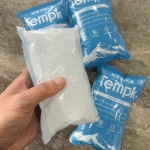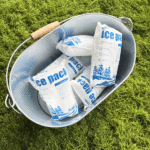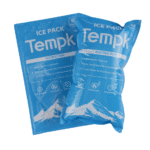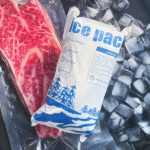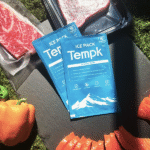سلسلة البرد المستدامة: How Can You Build an Eco Friendly Temperature Controlled Supply Chain?
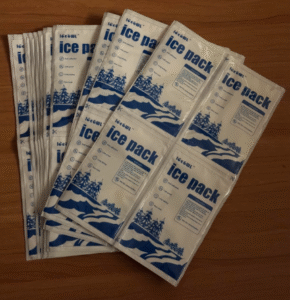
ال سلسلة التبريد المستدامة is more than a buzzword—it’s a necessary evolution for every business that ships or stores temperature sensitive products. بواسطة 2025 تقريبا 40 % of the world’s food relies on refrigeration, yet cooling accounts for roughly 15 % of global energy consumptionر. With the cold chain logistics market predicted to grow from USD 436.30 billion in 2025 to over USD 1.3 trillion by 2034ر, companies like yours must adopt greener strategies to meet regulatory and consumer expectations. In this guide you’ll learn how to design a sustainable cold chain that cuts carbon emissions, integrates renewable energy and smart technology, and safeguards product integrity. You’ll see how green logistics, AI driven insights and innovative packaging come together to create a supply chain that works for both your business and the planet.
What makes a cold chain sustainable and why should you care?
How can renewable energy, AI and IoT make cold logistics cleaner and smarter?
Which practical steps will help you reduce waste and energy consumption?
What regulatory and market trends affect sustainable cold chain management in 2025?
How can your business benefit from greener practices, and what tools should you use?
What makes a cold chain sustainable and why does it matter?
إجابة مباشرة: A sustainable cold chain minimises environmental impact while keeping products within safe temperature ranges. It achieves this by reducing energy use, adopting low carbon technologies and optimising logistics to prevent spoilage. بواسطة 2025 environmental sustainability is a requirement, not an option. Pressure to shrink carbon footprints comes from regulators, customers and investors. When your cold chain is sustainable, you reduce waste, save money and strengthen your brand.
توضيح:
A sustainable cold chain combines three pillars: كفاءة الطاقة, product safety and social responsibility. Your operations—from farms and factories to warehouses, trucks and retail—must work together to use less energy and cut greenhouse gas emissions. Studies show that cold chain operations are energy intensive; they face rising pressure to adopt greener practices and reduce their carbon footprint while maintaining efficiency. If you transport fruit at 0–5 °C or vaccines at 2–8 °Cر, keeping the right temperature matters as much as reducing fuel and electricity use. Adopting sustainable practices also reduces spoilage and protects public health: minor temperature deviations—even for two hours—can spoil an entire shipmentر. في جوهر, sustainability helps you do more with less while preserving product quality.
Key components of a sustainable cold chain
| عنصر | ركز | ينفع لك |
| كفاءة الطاقة | الطاقة المتجددة, smart HVAC | Lower operating costs, smaller carbon footprint |
| التحكم في درجة الحرارة | مستشعرات إنترنت الأشياء, precise monitoring | Improved product quality and compliance |
| Green logistics | تحسين الطريق, eco fuel | Reduced fuel consumption and emissions |
| التغليف المستدام | قابلة لإعادة الاستخدام, مواد قابلة لإعادة التدوير | Less plastic waste, better customer perception |
| Data driven decision | منظمة العفو الدولية, التحليلات التنبؤية | إدارة المخاطر الاستباقية, reduced spoilage |
نصائح وإرشادات عملية
Evaluate your energy sources: Switch to renewable energy such as solar or wind power for warehouse cooling systems and consider hybrid or electric refrigerated vehicles.
Conduct a carbon audit: Measure your current emissions from refrigeration, transportation and packaging. Use this baseline to set reduction targets and track progress.
Adopt circular packaging: Use recyclable insulated containers, biodegradable thermal wraps and reusable cold packs; these materials reduce waste and still maintain temperature.
تثقيف فريقك: Train employees on sustainable handling procedures and empower them to act on alerts quickly. Remember that human error remains a leading cause of spoilageر.
حالة حقيقية: A logistics firm installed solar panels on its cold storage roof and switched to electric delivery vans, خفض تكاليف الطاقة بنسبة 25 % while attracting eco conscious customersر. This simple change shows how sustainability and profitability can go hand in hand.
How can renewable energy, AI and IoT make cold logistics cleaner and smarter?
إجابة مباشرة: الطاقة المتجددة, artificial intelligence and Internet of Things (إنترنت الأشياء) technologies are transforming the cold chain. التبريد بالطاقة الشمسية, smart sensors and AI driven route optimisation help you reduce energy use and prevent product spoilage. With IoT devices providing real time monitoring and AI algorithms predicting disruptions, you can respond quickly and avoid losses.
توضيح:
Renewable energy and green logistics
Emerging cold chain facilities integrate renewable energy sources like solar and wind to power warehouses and refrigerated fleets. In Latin America and other regions, companies are adopting biofuels and renewable electricity. Solar powered cold storage units are particularly useful in areas with unreliable electrical grids; they reduce energy costs and improve access to remote regions. A switch from diesel powered to electric or hybrid refrigeration units helps lower emissions and operating expenses.
أجهزة استشعار إنترنت الأشياء والمراقبة في الوقت الحقيقي
تقوم أجهزة إنترنت الأشياء بمراقبة درجة الحرارة, humidity and location across warehouses, trucks and shipping containers. These sensors send real time alerts when temperature excursions occur, enabling you to take corrective action before product damage happens. Many companies now deploy GPS enabled IoT sensors that track both environmental conditions and shipment location simultaneously. This dual visibility reduces risk and ensures timely deliveries.
الذكاء الاصطناعي والتحليلات التنبؤية
AI algorithms process data from IoT sensors, weather forecasts and traffic conditions to predict disruptions and optimise routes. By analysing patterns, AI can suggest the most efficient and energy saving path for your shipments, reducing both fuel consumption and transit time. AI can also anticipate demand spikes—such as those during holidays or cultural events—and adjust inventory levels accordingly. في المستودعات, AI manages inventory and restocking to prevent stock outs and reduce overstocking.
Blockchain and digital traceability
Blockchain creates tamper proof records of every event in the cold chain. It enhances trust by ensuring that temperature data and handling events cannot be manipulated. With end to end digital ledgers, you can demonstrate regulatory compliance during audits and guarantee that products have been stored correctly. This transparency also helps build customer confidence.
طاولة: Technologies for a sustainable cold chain
| تكنولوجيا | Role in Sustainability | التأثير على عملياتك |
| Solar powered cooling | Powers cold storage and transport via renewable energy | Cuts energy costs and emissions |
| مستشعرات إنترنت الأشياء | Real time monitoring of temperature and location | Immediate alerts reduce spoilage |
| تحسين مسار الذكاء الاصطناعي | Predicts optimal routes and demand surges | Lowers fuel use and improves reliability |
| إمكانية تتبع البلوكشين | Secure ledger of temperature and handling events | Simplifies audits and builds trust |
| التغليف المستدام | Reusable and recyclable materials | Reduces waste and enhances brand image |
نصائح وإرشادات عملية
Install smart sensors: Deploy IoT devices at critical points—loading docks, cross docks and last mile delivery—to catch temperature excursions early.
Optimise routes with AI: Use predictive models to plan deliveries based on real time traffic and weather data. أقصر, more efficient routes save fuel and keep products within safe ranges.
دمج الأنظمة: Connect your warehouse management system (WMS), transport management system (TMS) and IoT dashboard into a single interface to gain a holistic view of your cold chainر.
اعتماد الطاقة المتجددة: Consider solar panels on warehouse roofs and electric refrigerated vehicles to reduce dependence on fossil fuels.
الاستفادة من blockchain: Use blockchain for secure recordkeeping of temperature logs and chain of custody events, simplifying compliance and building trust.
حالة حقيقية: During Ramadan, dairy distributors in Saudi Arabia used AI to forecast demand spikes weeks in advance, optimizing warehouse inventory and reducing emergency shipments. This combination of AI and IoT not only cut costs but also improved service quality.
What practical steps can help you reduce waste and energy consumption?
إجابة مباشرة: Reducing waste and energy consumption in your cold chain requires proactive planning, efficient packaging and continuous training. Mapping critical control points, selecting the right packaging materials and maintaining equipment will help you minimise losses and maximise efficiency.
توضيح:
Waste and energy inefficiencies often occur at handoff points: loading docks, cross docking facilities and last mile delivery. By identifying where temperature excursions are most likely, you can install additional sensors and design contingency protocols. Choosing insulation materials like vacuum insulation panels or phase change materials stabilises temperatures and prevents hot spots. Regular training ensures that staff respond quickly to alarms and follow standard operating procedures.
H3: Reducing waste through sustainable packaging
Sustainable packaging plays a crucial role in minimising waste and improving efficiency. حاويات معزولة قابلة لإعادة التدوير, biodegradable wraps and reusable cold packs reduce environmental impact and maintain thermal performance. Designing packaging for reuse or recycling supports circular supply chains and can even reduce shipping costs as lighter materials save fuel. عند اختيار التعبئة والتغليف, consider the product’s temperature requirements: vaccines need 2–8 °C, while gene therapies may require –70 °C.
| نوع التغليف | مادة | ينفع لك | Typical use cases |
| Recyclable containers | Corrugated or molded fibre | Reduces single use plastic waste | 2–8 °C shipments |
| أغلفة قابلة للتحلل الحيوي | Plant based foams | Minimises landfill impact | توصيل المواد الغذائية |
| Reusable cold packs | Gel or PCM filled | Maintains temperature over multiple trips | Medical kits |
| لوحات عزل فراغ | Ultra insulating boards | Achieves longer hold times with less material | –20 °C and below |
نصائح وإرشادات عملية
Map critical control points: Identify where temperature excursions are most likely (loading docks, cross docks, تسليمات الميل الأخير) and install extra sensors.
اختر العبوة المناسبة: Use materials like vacuum insulation panels or phase change materials to maintain steady temperatures and prevent hot spots.
خطة للخدمات اللوجستية العكسية: Set up systems to collect and reuse packaging materials. Reusable containers require tracking but deliver long term savings.
تدريب فريقك: Human error often leads to spoilage. Train staff to read IoT dashboards, respond to alerts and follow proper handling procedures.
حالة حقيقية: A global vaccine distributor replaced single use polystyrene boxes with reusable insulated containers, مما أدى إلى أ 30 % reduction in packaging waste and significant savings on procurement costs.
How do regulations and market forces influence sustainable cold chain management?
إجابة مباشرة: Regulations and market expectations drive sustainable cold chain practices. Agencies mandate strict temperature controls, documentation and calibrated monitoring devices, while consumers and investors demand transparent, eco friendly operations. Businesses that comply and innovate stand to gain a competitive advantage.
توضيح:
Global regulations—such as the FDA’s 21 جزء CFR 11, ممارسة توزيع جيدة (الناتج المحلي الإجمالي) guidelines and World Health Organization (من) recommendations—set the standards for temperature management, documentation and equipment calibration. These regulations require electronic records, calibrated sensors and documented corrective actions. في أثناء, national policies like Saudi Arabia’s Vision 2030 and the UAE’s Net Zero 2050 strategy encourage digitalisation and sustainable logistics. As investors focus on Environmental, Social and Governance (ESG) المقاييس, adopting greener practices also improves access to capital.
H3: Compliance and risk management
Regulatory compliance isn’t just about avoiding fines. It protects patient safety and ensures product efficacy. Real time monitoring with audit trails and digital signatures simplifies audits and reduces the risk of fraud. Companies that invest in compliance systems enjoy faster approvals and fewer recalls. فضلاً عن ذلك, policies promoting renewable energy and sustainable packaging support environmental goals and may provide tax incentives.
| Regulation or policy | غاية | Impact on your cold chain |
| GDP guidelines | Ensure proper storage and transport | Requires calibrated equipment and traceability |
| FDA 21 جزء CFR 11 | Mandate electronic records and signatures | Necessitates validated monitoring systems |
| WHO recommendations | Set international standards for vaccines | Require strict temperature control to maintain efficacy |
| Net Zero 2050 الاستراتيجيات | Promote renewable energy adoption | Encourage solar powered warehouses and electric fleets |
| ESG reporting requirements | Demand transparency on sustainability metrics | Drive investment in eco friendly practices |
نصائح وإرشادات عملية
التحقق من صحة المعدات: Ensure sensors and loggers are calibrated to recognized standards and keep maintenance records.
وثيقة SOPS: Write clear procedures for handling temperature excursions, corrective actions and documentation requirements.
Train for compliance: Teach staff to follow regulations and keep accurate logs. Use digital systems to simplify training and audits.
Monitor policy changes: Stay informed about new regulations and sustainability standards in your region.
حالة حقيقية: In the UAE, distributors trialled compostable packaging for perishables to align with national commitments to make all packaging recyclable or reusable. This initiative not only met regulatory goals but also improved customer perception.
How can you design a sustainable cold chain strategy?
إجابة مباشرة: Designing a sustainable cold chain strategy involves defining product requirements, setting temperature ranges, mapping your logistics network and integrating technology. By focusing on continuous improvement and leveraging data, you can build a resilient system that scales with your business.
توضيح:
A sustainable strategy starts with product requirements: different goods demand specific temperatures and humidity. Fruit may require 0–5 °C; vaccines need 2–8 °C; frozen foods must stay below –18 °C; dairy around 1–3 °C; and advanced biologics require ultra cold conditions like –70 °Cر. التالي, map the origin and destination points, as they shape your logistics and influence infrastructure investments. أخيراً, plan distribution methods—including refrigerated trucks, reefer containers and last mile solutions—and incorporate IoT sensors and AI to monitor conditions and optimise routes.
H3: Building an end to end strategy
To build an end to end strategy:
Define temperature ranges for each product line and set tolerance levels (على سبيل المثال, ±2 °C outside target for 30 دقائق).
Select appropriate devices—interval loggers for storage and real time trackers for transit.
تعيين الأدوار: identify who receives alerts and who implements corrective actions.
Document and validate the system: maintain digital records and perform regular audits.
Plan contingency routes: develop alternative routes or backup power sources for emergencies.
طاولة: Sustainable cold chain workflow
| خطوة | وصف | Outcome for you |
| Define product needs | Determine acceptable temperature ranges | Guides equipment selection |
| Deploy monitoring | Install sensors in warehouses and vehicles | Provides real time data |
| Set alert thresholds | Establish tolerance windows (على سبيل المثال, ±2 °C) | Triggers timely response |
| تدريب الموظفين | Educate staff on SOPs and emergency actions | يقلل من الخطأ البشري |
| Review data and adapt | Analyse excursion patterns and tweak routes | تحسين مستمر |
نصائح وإرشادات عملية
Use stress tests: Simulate power loss or open door events to ensure that your monitoring system catches anomalies and alerts the right person.
توحيد الشحنات: Group compatible temperature ranges in the same delivery to maximise vehicle utilisation and reduce emissions.
Implement reverse logistics: Plan to recover reusable containers and packaging materials for future shipments.
إشراك الشركاء: التعاون مع الموردين, carriers and customers to align sustainability goals across the supply chain.
حالة حقيقية: A logistics company integrated its cold chain system with its ERP software, enabling better coordination between production, storage and distribution teams. This integration improved visibility and reduced delivery times.
2025 latest sustainable cold chain developments and trends
نظرة عامة على الاتجاه: ال 2025 landscape for sustainable cold chains is marked by rapid technological advancement, market growth and regulatory pressure. Environmental sustainability has become mandatory, leading to innovations in green logistics, renewable energy and resilience to climate change. Let’s explore the latest developments and what they mean for you.
آخر تقدم في لمحة
الخدمات اللوجستية الخضراء والطاقة المتجددة: Companies are shifting to renewable energy sources and eco friendly facility designs. Biofuels and clean electricity power refrigerated fleets and warehouses. Solar powered cold storage units cut energy costs and extend cold chain services to regions with unstable grids.
AI driven predictive maintenance and route optimisation: AI predicts equipment failures and suggests optimal routes, reducing downtime and fuel consumption. Predictive analytics help anticipate demand spikes (على سبيل المثال, Ramadan surges) and adjust inventory and transport capacity.
Blockchain للتتبع: Blockchain is used to create secure records of every shipment event, strengthening compliance and reducing fraud. Tamper proof ledgers build trust with regulators and customers.
التغليف المستدام: Innovations include recyclable containers and biodegradable thermal materials. These solutions reduce plastic waste and align with regulatory goals such as the Move to –15 °C initiative for energy efficient refrigeration.
Expansion of cold storage facilities: Outsourcing and built to suit solutions are increasing, allowing companies to access state of the art facilities without high capital expenditure. New facilities emphasise energy efficiency and resilience to climate events.
رؤى السوق:
The global cold chain logistics market is set to surge from 436.30 مليار دولار أمريكي 2025 to over USD 1.3 trillion by 2034ر. تقريبا 40 % of the world’s food relies on refrigerationر, and cooling represents about 15 % of global energy consumptionر. في الشرق الأوسط, sustainability is embedded in national agendas, with initiatives like Saudi Arabia’s Vision 2030 driving investments in renewable energy and green logistics. Demand for ultra cold storage is growing due to the rise of gene therapies and mRNA vaccines, which require temperatures below –70 °C.
ماذا يعني هذا بالنسبة لك:
استثمر في التكنولوجيا: أنظمة المراقبة الذكية, AI analytics and blockchain traceability are no longer optional. They are critical for compliance, efficiency and customer trust.
إعطاء الأولوية للاستدامة: Align your operations with national and global sustainability goals to reduce emissions and access green financing.
Stay resilient: Climate change increases the frequency of extreme weather events. Building resilient infrastructure and diversifying transportation modes reduces risks.
التعاون: Partner with suppliers and customers to share data and drive sustainability across the entire supply chain. Sharing information via blockchain and integrated dashboards fosters transparency and reduces duplication of effort.
الأسئلة المتداولة
س 1: What temperature ranges should I monitor in a sustainable cold chain?
Different products require distinct temperature zones. Fruit typically needs 0–5 °C, اللقاحات 2-8 درجة مئوية, frozen foods below –18 °C, dairy around 1–3 °C and advanced biologics may require ultra cold conditions such as –70 °Cر. Monitoring the correct range ensures product integrity and reduces energy waste.
Q2: Do I need real time monitoring, or are interval loggers sufficient?
Real time monitoring is strongly recommended, especially for high value or sensitive products. IoT sensors provide immediate alerts, while interval loggers may miss excursions during transit. Combining both technologies offers comprehensive coverage.
س 3: How can I reduce the carbon footprint of my cold chain?
Switch to renewable energy sources such as solar or wind, optimise routes with AI to reduce fuel consumption, use energy efficient refrigeration and adopt recyclable or reusable packaging. You can also lower temperatures from –18 °C to –15 °C where safe, which significantly reduces energy consumptionر.
س 4: What role does blockchain play in sustainable cold chain management?
Blockchain provides secure, tamper proof records of every event in the cold chain, ensuring data integrity and simplifying audits. It builds trust among stakeholders and helps meet regulatory requirements.
س 5: What is the Move to –15 °C initiative?
The Move to –15 °C initiative promotes energy efficient refrigeration by adjusting frozen storage temperatures from –18 °C to –15 °C. Research shows this small temperature change can reduce energy consumption without compromising product safety, making it a key part of sustainable cold chain strategies.
ملخص وتوصيات
الوجبات الرئيسية:
A sustainable cold chain balances energy efficiency, product safety and environmental responsibility. It’s not optional—sustainability is a requirement.
Technologies such as renewable energy, مستشعرات إنترنت الأشياء, AI and blockchain drive smarter, cleaner logistics. Real time monitoring and predictive analytics reduce waste and improve efficiency.
Practical actions—mapping critical control points, choosing sustainable packaging, training staff and integrating systems—help you reduce emissions and prevent spoilage.
Compliance and market forces push companies toward eco friendly practices. Adhering to regulations and ESG standards protects your brand and opens opportunities.
Staying informed about trends—like the Move to –15 °C, sustainable packaging and ultra cold storage—ensures you remain competitive in a rapidly evolving market.
الخطوات التالية القابلة للتنفيذ:
Perform a sustainability audit: Assess your energy use, packaging waste and carbon footprint. Set measurable reduction targets.
Invest in real time monitoring: Deploy IoT sensors and integrate them with AI analytics for predictive maintenance and route optimisation.
اعتماد الطاقة المتجددة: Install solar panels on facilities, switch to hybrid or electric refrigeration vehicles and explore biofuels for long haul transport.
ترقية التغليف: Transition to recyclable or reusable insulated containers and test biodegradable materials.
التعاون عبر سلسلة التوريد: Share data with partners through secure platforms like blockchain to improve transparency and compliance.
تثقيف فريقك: Provide ongoing training on sustainability practices, regulatory requirements and new technologies.
حول Tempk
نحن في Tempk are pioneers in eco friendly cold chain solutions. Our products combine مستشعرات إنترنت الأشياء, تحليلات تعتمد على الذكاء الاصطناعي و renewable energy options to create sustainable cold chain systems tailored to your needs. نحن نتصميم التعبئة والتغليف القابلة لإعادة الاستخدام and implement التبريد بالطاقة الشمسية to reduce your carbon footprint. With decades of experience and a commitment to innovation, we help you safeguard product integrity while achieving sustainability goals.
الخطوة التالية: Contact Tempk today for a consultation on designing a sustainable cold chain. Our experts will analyse your current operations, recommend eco friendly technologies and guide you toward a greener, more resilient supply chain.
















